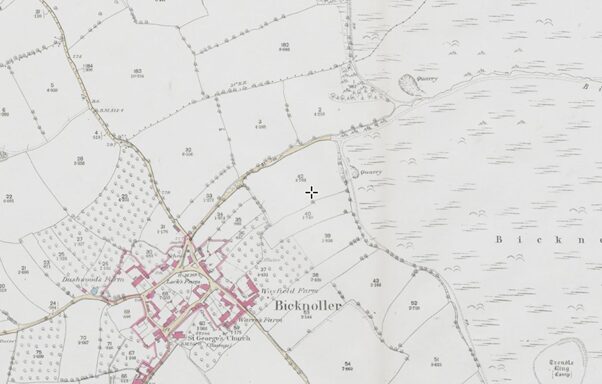Geologist Garry Dawson delves into the deep-time and the human history of Bicknoller Quarry
The rocks exposed in Bicknoller Quarry are Devonian age Hangman Sandstones – see Geology Map below. These were sands and muds deposited around 390 to 380 million years ago (mya) by a large river system flowing southwards, across a coastal plain, from higher ground to the north. Features seen in the rocks, such as current ripples and local changes in grain size, have been interpreted by geologists to show that meandering channels would have been common with occasional fast flowing floods.
There was little vegetation at that time but some plants and small trees would have grown where the river channels deposited more mud.

During earth movements these sand and mud sediments were subsequently buried beneath later sediments to a depth of several kilometres in the earth’s crust. The pressures and temperatures the sediments were subjected to changed them from soft and unconsolidated sediments to the hard sandstone we see today.
After burial the rocks were folded by movements of the earth’s tectonic plates and later erosion removed younger rocks above to bring the Devonian rocks to the surface.
Until recently geologists thought that there was very little vegetation cover in this area but scientific papers published in 2023 and 2024 described the surprising discovery of numerous plants and small trees (forming the world’s oldest forest) in rocks of the same age on the Exmoor coast. See https://www.bbc.co.uk/news/science-environment-68500649
The plant and tree fossils recently discovered occur in rocks containing more mud than sand. Quarries such as Bicknoller were opened up in the sandy rocks and probably don’t contain tree fossils. On the coast, erosion has exposed all the different rock types within the Hangman Sandstone from sandstones to mudstones.
History
It is not clear when Bicknoller Quarry was first worked but the earliest maps showing it were published by the Ordnance Survey in 1888. At that time, it appears to have been a similar size to today. Earlier, 1841 Tithe Maps, do not show the quarry but neither do they show other quarries in the area. The size of the quarry in 1888 suggests it could have been worked before 1841 but was simply not shown by the 1841 maps. Further research will be required to fully investigate its history.
The quarry was used for building stone and roadstone.

Building Stone
Since 2015 I have been surveying building stones for the Somerset Heritage Centre (SHC). The data for Bicknoller shows 70% of the building stone used in the houses and the church is Hangman Sandstone and 30% is Triassic age red sandstone – see Figure 3. The latter are from beds of Otter Sandstone or the Budleigh Salterton Pebble Beds. The survey has shown that building stone, being expensive to transport, is usually used locally so it’s likely that stone extracted from the Bicknoller Quarry was used in the area. The Triassic stone, 250 to 245 mya, would have come from quarries a little further away, for example at Woolston and Stogumber. For more information on the building stone survey see https://swheritage.org.uk/historic-environment-service/built-heritage/traditional-building-stone-research/ .

Roadstone
Until the early 20th century, it was usual for piles of stone from local quarries to be left by the side of local roads for use when needed in repairs. The archives at the SHC contain accounts of a dispute in 1905 between Ecclesiastical Commissioners for England and Williton Rural District Councilabout the right of WRDC to take stone from the quarry for repairing roads – see https://somerset-cat.swheritage.org.uk/search/all:records/0_50/all/score_desc/bicknoller%20quarry
Garry Dawson, Somerset Geology Group, www.somersetgeology.org.uk